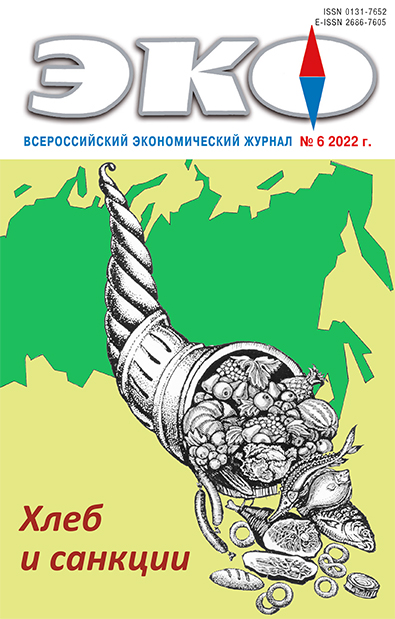ECONOMY SECTORS AND MARKETS
Development of Copper Industry in Russia and Mongolia: The Problem of Access to Foreign Markets
Published 2022-05-27
Keywords
- Mongolia; Russia; China; copper; export; import; foreign markets; transport costs; competitiveness; transport and geographic location
How to Cite
1.
Bezrukov Л, Fartyshev А. Development of Copper Industry in Russia and Mongolia: The Problem of Access to Foreign Markets. ECO [Internet]. 2022 May 27 [cited 2025 Dec. 16];52(6):115-33. Available from: https://ecotrends.ru/index.php/eco/article/view/4451
Abstract
The paper considered the problem of competitiveness of Mongolian and Russian (East Siberian) mineral commodities on foreign markets is considered through the example of copper industry. The analysis of world copper market conditions and the place of China, Russia and Mongolia on it is given. Comparative characteristics of large copper deposits developed and being prepared for development in Mongolia (Erdenetin Ovoo and Oyuu Tolgoi) and Eastern Siberia of Russia (Bystrinskoye, Udokanskoye, Ak-Sugskoye, Kingashskoye) are presented. The assumption that the rivalry between Mongolian and Russian copper exporters for foreign markets, primarily Chinese, may intensify has been substantiated. An assessment of the transport and geographic location of the deposits relative to the nearest Chinese industrial centers and sea export ports was made, which showed the advantages of Mongolia’s deposits compared to those in eastern Siberia. The SWOT analysis confirmed that deeper processing of raw materials provides more favorable conditions for the East Siberian copper products to enter foreign markets, including easing the risks of competition with Mongolia.References
- Безруков Л., Фартышев А. Особенности внешней торговли Монголии: риски для России // Мировая экономика и международные отношения. 2022. Т. 66. № 3. С. 101–109. DOI: 10.20542/0131–2227–2022–66–3–101–109
- Безруков Л. А. Континентально-океаническая дихотомия в международном и региональном развитии. Новосибирск: Академическое изд-во «Гео», 2008. 369 с.
- Горячев Н. Н. Китайские горнодобывающие компании в Перу: существует ли единая причина проблем? // Российско-китайские исследования. 2021. Т. 5. № 3. С. 141–150. DOI: 10.17150/2587–7445.2021.5(3).141–150
- Данилов Ю. Г., Никифорова В. В., Леонтьев С. П., Константинов Н. Н., Хосоев Д. В. ГОК «Эрдэнэт»: история и перспективы развития // Горная промышленность. 2019. № 5. С. 24–27.
- Иванов А. Основные направления развития военной промышленности КНР // Зарубежное военное обозрение. 2013. № 2. С. 18–30.
- Капустина Л. М., Фальченко О. Д., Древалев А. А. Влияние экономическoго цикла на конъюнктуру мирового рынка меди // Научные труды Вольного экономического общества России. 2018. Т. 211. № 3. С. 481–498.
- Кондратьев В. Б., Попов В. В., Кедрова Г. В. Глобальный рынок меди (продолжение) // Горная промышленность. 2019. № 4. С. 100–104. DOI: 10.30686/1609–9192–2019–4–100–101
- Кудияров С. С верой в электромобили // Эксперт. 2018. № 40. С. 22–23.
- Лабыкин А. Быстринский ГОК набирает обороты // Эксперт. 2018. № 39. С. 55–56.
- Макаров А. В., Макарова Е. В., Михеева А. С. Внешнеэкономические связи Монголии: современная ситуация и проблемы развития // ЭКО. 2019. № 6. С. 62–82. DOI: 10.30680/ЕСО031–7652–2019–6–62–82
- Пармон В. Н., Крюков В. А., Селиверстов В. Е. Трансграничные взаимодействия на Востоке России: научное сопровождение и задачи Сибирского отделения РАН // Регион: экономика и социология. 2020. № 2. С. 226–258. DOI: 10.15372/REG20200210
- Турунцев А., Обухова Е. Сырьевой шторм // Эксперт. 2022. № 1–2. С. 53–55.
- Ульянов Н. За медный грош // Эксперт. 2019. № 15. С. 22–24.
- Чупина Д. А. Влияние «зеленого» курса на импорт меди из России в ЕС // Вопросы экономики. 2022. № 1. С. 110–125. DOI: 10.32609/0042–8736–2022–1–110–125

